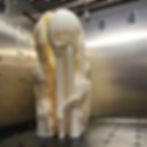How Much Does 3D Printing Cost?
- thereyouhaveit3d
- Nov 15, 2021
- 10 min read
Updated: Jul 24
So how much does 3D printing cost? When considering initial costs, the price of 3D printing, in general, can vary depending on the complexity, size, and intricacy of the 3D print. A low-complexity, small 3D print may only cost $0.50 to produce, while a high-complexity, larger 3D print might cost around $400.
Sometimes the cost is also affected by the overall time it takes to make a 3D print from start to finish, but you can reduce costs by optimizing your process.. To reduce expenses, it's crucial to implement efficient processes. Additionally, the type of materials used, including resin materials, can significantly impact the cost and overall profitability.. For more info, please read our helpful article, How Long Does 3D Printing Take? Learn more about 3D print timing and timelines.

This article will help you understand what goes into pricing so you can make an informed decision before making a purchase.
Understanding 3D Printing Costs
Whether you’re a hobbyist looking for a cost-effective way to create personal projects or a business owner aiming to optimize production, understanding the costs involved in 3D printing is crucial for success. Product designers and engineers also need to account for the varying costs depending on material and printer type, especially when striving for high-quality, functional prototypes.
Understanding the costs associated with 3D printing is crucial for individuals and businesses looking to invest in this technology. For those running a 3D printing business, managing costs effectively can lead to increased profitability and scalability. The cost of 3D printing can vary greatly depending on several factors, including the type of 3D printer, materials, print size, complexity, energy use, and maintenance. Using expensive materials, for instance, can significantly impact the overall cost. Each of these components plays a significant role in the overall cost calculation, and managing these costs effectively can lead to more efficient printing and better profitability.
When considering the actual cost of 3D printing, it’s essential to look beyond the initial purchase price of the printer. Material costs, electricity costs, and maintenance costs all add up over time, contributing to the overall operational costs. Additionally, the complexity, print time, and size of the print can significantly influence the final price. To make informed decisions, For accurate cost forecasting, use a 3D printing cost calculator that takes into account factors like material cost, energy consumption, and labor. This will help you estimate the total cost per project and make informed decisions on whether to outsource or print in-house. Additionally, regularly reviewing your print efficiency metrics—such as material usage per print—can help optimize future project costs. it's essential to calculate the total cost of ownership, including all these factors. By understanding these various elements, you can make more informed decisions and optimize your 3D printing processes for both quality and cost-effectiveness, improving overall profitability.
Factors That Influence the Cost of 3D Printing
Several factors influence the cost of 3D printing, and it's important to factor in potential hidden costs as well:
Material costs: The type and quantity of materials used in 3D printing can significantly impact the overall cost. Basic materials like PLA and ABS are generally more affordable, while specialized materials or composites, including high-quality materials, can be more expensive. Material consumption also varies based on the complexity and size of the print, affecting the final cost.
3D printer costs: The average cost of a 3D printer itself is a significant investment. Prices can range from a few hundred dollars for basic desktop models to tens of thousands of dollars for industrial printers. This initial investment is crucial to consider, especially for businesses looking to scale their operations.
Energy consumption: The power consumption of the 3D printer and the local electricity rates can affect the energy costs. Efficient printing practices and choosing energy-efficient models can help manage these costs, resulting in cost savings.
Maintenance costs: Regular maintenance is essential to ensure the optimal performance and longevity of a 3D printer. Cost of maintenance can include the replacement of consumable parts and labor costs. Common maintenance tasks include nozzle replacements, which can cost around $20 each and should be replaced after approximately 200 hours of printing. Printer calibration is another regular task that can affect print quality and efficiency, taking up to an hour for industrial models but significantly less for desktop printers Keeping your printer in good condition can prevent costly repairs and downtime.
To reduce maintenance costs, it's important to regularly clean and calibrate your printer. Simple actions like replacing worn-out nozzles or cleaning the build plate after each print can extend the lifespan of your machine. Additionally, choosing printers with self-calibration features can reduce the need for frequent manual intervention.
Labor costs: Labor costs can be a significant factor in the cost of 3D printing, particularly in professional or commercial environments. Skilled operators are needed to manage the printing process, perform post-processing, and ensure print quality.
Leveraging automation in 3D printing can significantly reduce labor costs by streamlining the print preparation process and automating repetitive tasks like material loading and print start sequences. Investing in automation tools can increase your overall production efficiency, especially in high-volume manufacturing environments.
Overhead costs: Overhead costs, such as facility costs and equipment expenses, can also impact the overall cost of 3D printing. These costs are often overlooked but can add up, especially in larger operations.
By considering these factors, you can better understand the true cost of 3D printing and make more informed decisions about your investment.
Outsourced Production vs. In-House 3D Printing
For small businesses or startups, outsourced 3D printing can be an affordable option for low-volume production, while larger enterprises may find that investing in in-house printing equipment offers more control and scalability. Engineers and designers benefit from in-house operations due to faster prototyping and reduced lead times, essential for product iteration and testing.
The truth is that 3D printers have quickly become an integral part of many industries and can be found in offices all over the world. In industries like healthcare, 3D printing is revolutionizing the production of custom prosthetics and medical devices, offering a cost-effective alternative to traditional manufacturing. In the automotive industry, 3D printing enables rapid prototyping of vehicle parts, reducing the time and cost involved in bringing new designs to market. For consumer goods, 3D printing provides businesses with the flexibility to offer customized products at a lower cost than traditional manufacturing methods
They're the newest way to produce a wide range of products quickly, applicable across a wider range of applications. 3D printing can be used to create a fully customize product, tailored specifically for the customer, using innovative techniques.
In today's world, there are two methods of 3D printing: outsourced production and in-house 3D printing. With outsourced production, you send your designs and specifications to the manufacturer and they build your product for you based on those specifications. In-house 3D printing is the tried and true way to produce a large volume of custom parts efficiently.
When deciding between outsourced production and in-house 3D printing, it’s important to consider several factors. Outsourcing requires no upfront investment in printers or staff, making it ideal for smaller, occasional projects. However, in-house printing becomes more cost-effective as production volume increases, as it allows you to control production times and materials, and avoid ongoing service fees. Additionally, outsourcing often leads to longer lead times, whereas in-house printing provides flexibility and faster turnaround for urgent projects

In China, there are many small workshops that function as companies' in-house production facilities. However, manufacturing your own 3D printed parts has its disadvantages. It requires a lot of on-site space and equipment, which can be expensive, on top of paying for employees with the proper skill set to run the machines.
3D Printer Costs
The cost of a 3D printer can vary greatly depending on the type and quality of the printer. Here are some general price ranges for different types of 3D printers:
FDM (Fused Deposition Modeling) printers: FDM printers are the most affordable option, with prices ranging from a few hundred dollars to $2,000 to $6,000. These printers are popular for their versatility and ease of use, making them a great choice for beginners and hobbyists.
Desktop SLA (Stereolithography) printers: Desktop SLA printers start from around $2,000 to $3,000. These printers offer higher print quality and are ideal for detailed and intricate designs.
SLS (Selective Laser Sintering) printers: SLS printers, which use direct metal laser sintering, typically cost $10,000 plus. They are used for industrial applications and can produce high-strength, durable parts.
Larger-scale industrial machines: Larger-scale industrial machines of any technology cost significantly more, often reaching into the tens of thousands of dollars. These machines are designed for high-volume production and offer advanced features and capabilities.
Types of 3D Printers and Their Prices
Type of 3D Printer | Price Range |
FDM | $200-$6,000 |
Desktop SLA | $2,000-$3,000 |
SLS | $10,000 |
Industrial | $50,000 |
Considerations Beyond Direct Costs: Post Processing
3D printing has been a hot topic in recent years, and its popularity is continuing to increase. The cost of a 3D printer, including 3D printer prices, can vary greatly depending on the type and quality of the printer. Post-processing can add significant value to the final product despite contributing to additional costs, especially when additional materials are required. Minimizing post-processing costs can be achieved by optimizing your 3D print settings, such as lowering the infill percentage or selecting a finer layer height to reduce the need for extensive post-processing. Additionally, choosing a 3D printer that produces high-quality prints with minimal defects can significantly reduce post-processing labor.
To achieve a high level of precision, post-processing is often necessary, but it can also help to minimize errors and defects. The extra costs associated with 3D printing cover more than just the cost of the actual machine.
When 3D printing something, you should also factor in the time it will take to design the 3D objects as well as the cost of ink cartridges to ensure you come out on top. To get the most out of your 3D printing cost, you can use a 3D printing cost calculator to accurately estimate costs and find a printing service with affordable yet high-performance software, hardware, and materials that can help you work in a time-efficient manner.
Electricity Consumption and Energy Costs
The energy cost of a 3D printer depends on usage and local energy prices. For regular use, the energy cost of an UltiMaker 3D printer is around $50 per year. For more energy-intensive models like the MakerGear M2, which consumes 200W, the yearly energy cost rises to approximately $200. Understanding the energy requirements of each printer model can help you choose the most cost-effective option based on your specific usage needs
It’s essential to consider the energy efficiency of a 3D printer, as it can significantly impact the overall cost. To estimate energy costs accurately, check the power consumption specs of a 3D printer, considering the average electricity consumption of the device. Here are some examples of power consumption and annual energy costs for different 3D printer models:
3D Printer Model | Power Consumption | Energy Cost (per year) |
UltiMaker | 50W | $50 |
Prusa i3 | 100W | $100 |
MakerGear M2 | 200W | $200 |
By understanding and managing these energy costs, you can ensure that your 3D printing operations remain cost-effective and sustainable, ultimately reducing waste and operational costs. Additionally, using a 3D printer with precision temperature control can help minimize waste and optimize energy usage, leading to a more environmentally friendly and cost-effective printing process.
3D Printing Service Price Comparison
With the introduction of 3D printing, more businesses are getting into this new technology. One of the first things that strikes people is the cost. However, printing prices can vary based on many factors. 3D printing service prices can range from $10 to upwards of $5,000 depending on what is being printed, and the location of the different materials being used.
It's best to always search and compare your options among different service providers before making a decision on where to buy so that you get the best deal for your order and reduce operational costs.

How 3D Printing Material Cost Affects Overall Cost?
The cost of 3D printing materials can vary substantially, depending on the range of materials used and the type of printing material being used. A range of factors influence the cost of the printed items, including the type of filament required, color, production volume, and more. Resin materials, whether standard or specialized, can significantly affect overall expenses due to their versatility and quality. 3D printers will use a specific type of filament to produce certain objects which are then ready for use.
The most common materials that are used for this purpose are ABS plastics, PLA plastics, TPUs, and Nylons, with each filament type affecting the cost and quality of the print. The higher the quantity and quality of the material used for the 3D model, the better the print quality will be, but the material cost will also increase.

How Much Does a 3D Model's Actual Cost?
3D modeling is a very demanding task, though it's a popular choice for designers, architects, engineers, and anyone looking for affordable and functional prototypes, so it takes time for 3D scanning to create a realistic 3D design.
Again, the pricing varies on the complexity of the project and the type of 3D printing material used. Prices are usually negotiable, so it's important to select and get several quotes before deciding on one. Models are more affordable if they're smaller or less detailed. The most escalable and cost-effective option is to use an automated model generator, but this often ends up with an imperfect model which would have to be edited manually.

Why is 3D Printing So Expensive?
3D printing has been around for a few decades, but in recent years, it's been gaining a lot of popularity in the industry. The reason why it's expensive is that it uses a different type of ink and has a variety of different materials such as plastic, metal, or ceramic to print 3D objects one layer at a time using computer-aided design (CAD) to guide their movements. The increasing use of automation in 3D printing has improved efficiency and reduced print time, but also added to the initial investment cost.
These materials are often much more expensive than traditional materials and can cost thousands of dollars for just a small amount, which can affect the cost for both money and time. Furthermore, the ability to customize and create complex designs with 3D printing requires a high degree of flexible manufacturing capabilities, which can drive up costs. The 3D printer itself is also quite pricey.

How Long Does 3D Printing Take?
The advent of 3D printing technology has led to a growing demand for businesses that offer the service, thanks to its innovative approach to manufacturing. People are eager to have their ideas turned into physical objects in less time than they ever thought possible. While the process may vary depending on what's being printed, there are some general guidelines. The time needed, also known as turnaround time, usually takes anywhere from 8-12 hours depending on how detailed or complex the design is, what material is being used, and how big it is.
By understanding these guidelines, businesses can forecast their production timelines and plan accordingly to ensure time-efficient processes. Additionally, 3D printing is often used for prototyping, allowing companies to test and refine their designs before moving into full-scale production, which can help reduce costs and improve overall efficiency.

If you want to learn more about 3D printing or to start printing your 3D project, find us by 3d printing service near you and you get in touch with the experts at There You Have It 3D.







